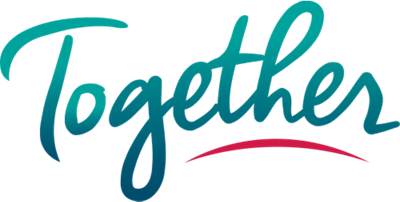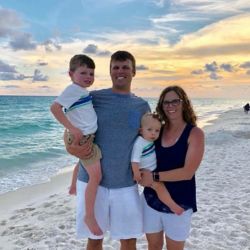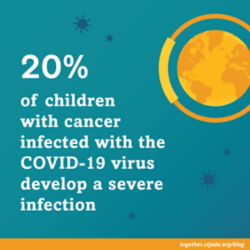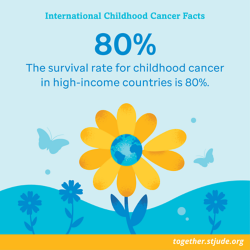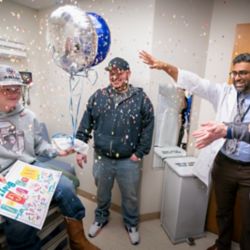St. Jude President and CEO Dr. James Downing's Message to Families on Childhood Cancer Awareness Month
In elementary school, I lost a classmate to childhood leukemia. In the early 1960s, few pediatric cancer patients lived. By the time I entered medical school, hope was on the horizon. More than 50% of children with the disease survived. Today, at St. Jude, where I serve as president and CEO, more than 90% of leukemia patients are cured. These hard-won gains were made over decades by doctors, scientists and many others who believed children deserve a future.
This commitment continues. September is Childhood Cancer Awareness Month. It is a time to honor patients and families who face cancer diagnoses, to celebrate victories over the disease, and to urge policymakers worldwide to prioritize pediatric cancer research and treatment.
Although more than 80% of children with cancer in the U.S. are cured, there is much work to do. Some forms of the disease remain incurable. Survival rates have plateaued for others. Relapses are difficult to treat. A shocking 9 in 10 children with cancer perish in low- and middle-income countries.
In science and medicine, advances are often made step by step. Knowledge builds on top of knowledge over years and decades. But for children and their families today, how do we offer the promise of progress?
Connecting the Dots
Cancer is triggered by changes, or mutations, in the DNA of normal cells. Genome sequencing is a way to find out the order of the four chemical building blocks—called “bases”—that make up DNA. If scientists can better understand the cancer genome, they can explain why the disease arises, spreads and resists treatment.
A decade ago, St. Jude started the Pediatric Cancer Genome Project. This first-of-its-kind effort would unlock the mysteries hidden in the DNA of some of the rarest and hardest-to-treat childhood cancers. The project involved nearly 200 researchers and $95 million. This investment of talent and resources has added volumes of information to what is known about the biology of 23 types of cancer. The project also led to the finding that almost 10% of children are born with genetic changes that increase their risk of developing cancer.
The Pediatric Cancer Genome Project ushered in an era of discovery that spurred new computational tools, research programs, clinical trials and initiatives. In many ways, it is the tip of an iceberg. Scientists worldwide have only begun to explore the vast landscape of data generated by the project.
At St. Jude, we have made further investments in fundamental science, fueled by insights made by the project and other avenues of scientific inquiry. These efforts will accelerate our ability to develop novel therapies. Our hope is that what we’re learning in Memphis will also help researchers uncover cures in communities near and far.
Connecting the World
Each year, more than 400,000 children worldwide are diagnosed with cancer. In the U.S, most have access to quality care, regardless of where they live. Sadly, around the globe, this is not the case. More than 80% of children with cancer live in low- and middle-income countries, where the overwhelming majority will die from their disease.
Solving the global pediatric cancer problem is the next frontier.
While the dream is daring, it is within reach. Through a new initiative, St. Jude Global, we are joining health care providers internationally and sharing the training, technology and tools that lead to discovery and innovation. To date, more than 121 institutions across 57 countries have joined. What’s more, St. Jude is working with World Health Organization and others to raise survival rates in low- and middle-income countries to 60% for six of the more common forms of pediatric cancer by 2030.
These efforts will help answer fundamental questions that inform care for children at home and abroad. Is cancer in the Middle East, Africa or Central America the same that we see in the U.S.? Are the causes of cancer different? How do backgrounds or environmental factors influence response to therapy? And, much more.
Connecting Together
When parents learn their child has cancer, fear is often followed by frenzied typing. The COVID-19 pandemic has shown how quickly medical misinformation is spread. For diseases like cancer, reliable and trustworthy information is too often scattershot across websites.
Three years ago this month, we launched Together as a place where families can turn to learn about pediatric cancer, its diagnosis and treatment, care and support, and survivorship. Since then, more than 2 million users from 200-plus countries and territories, all 50 states and all 10 Canadian providences have accessed the site. The topics are offered in Arabic, Burmese, Chinese, English, French, Hindi, Russian and Spanish. More translations will follow.
The road from diagnosis to treatment to survivorship may be long. Through the community found on Together, families can find support every step of the way.
Connecting to a Dream
It’s been 40 years since I started a career in science and medicine. It has been an easy job to love. There are always new frontiers to explore and boundaries of discovery to push. Most of all, there is joy in knowing that your work one day might help a family at the moment they need it the most. This month and all that follow, know that nurses, doctors, scientists and many more are working to make the future brighter for families like yours.
